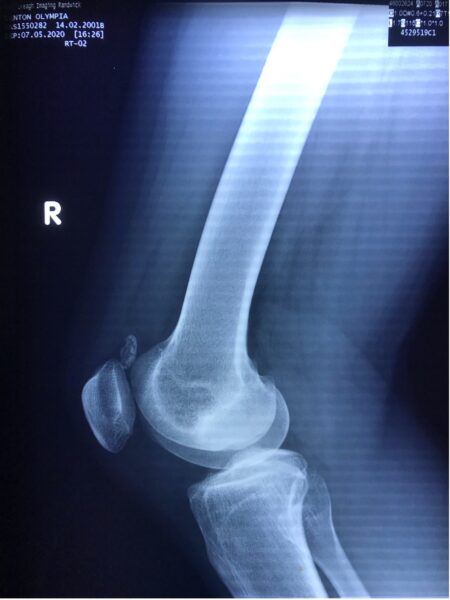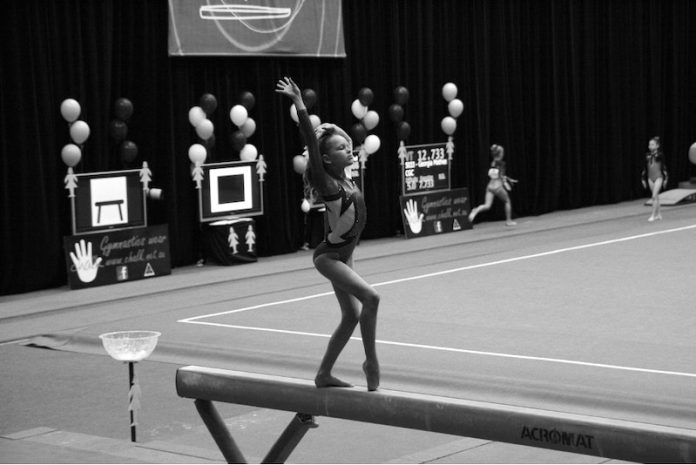There are small things that remain, five and a half years since throwing in the towel.
Things which have showed such an unexpected endurance I’d no longer be surprised if they stuck around till the day I die. Silly things, ugly things, funny things and secret things… the glitter that permanently occupies my wardrobe floor, stiff callouses on my palms, the way my shoulders are wider than my hips, and the tight breathlessness in my abdomen whenever I pass the old gym.
I retired from artistic gymnastics in 2016, my final season meeting its premature end with two torn ligaments in my left ankle and a chunk of my femur coming away into the knee joint. I was among the more fortunate of my teammates, who shared between them two stress-fractured spines, two ankle reconstructions, a foot broken in three places and an Achilles hardened with tendinitis.
This slew of injuries emerged with gradually burgeoning discomforts; an ache that started one day and never went away; a joint that stiffened over months until one day you woke up to find it fat and purple. Nothing to worry about, at first.
Always begging the question… Why?
It’s no secret that women’s gymnastics has favoured the slight, pre-adolescent figure for some time. By the 1970s the dominance of Soviet teenagers Ludmilla Tourischeva, Olga Korbut and Nadia Comaneci showed irrevocably that to distil the stuff from which champions were made we must concentrate talent, hard work and courage into the smallest possible figure.
Admittedly, kids are flexible, light… more obedient.
That decade, the age of a gold-medal-winning gymnast plummeted from 31 to 14 and what had once been a marathon became a sprint.
* * *
Tokyo 2021
For the first time since 1968, the median age of an Olympic gymnast is in her twenties again. It was funny, in a hollow way, to watch the Games and remind myself that this quad was my quad. These women started at the same time I did. Did they know then where it would take them?
For any gymnastics neophyte, it is often the floor exercise that first enraptures. In this event, no gymnast is more exalted than Simone Biles, and with good reason. There’s something alien in her flight, a sensitivity to gravity that seems to stretch the bounds of what is possible. How does she fly so high? Let’s start there.
Every action must have an equal and opposite reaction.
In her first three steps, thigh and calf muscles press down the springs under the carpet, resisting her weight and propelling her on. She pitches her body forward and some of her momentum becomes rotational, or angular momentum, pulling her feet over her head, stomach holding her rigid about her axis.
The first handspring is long, at least two metres, carrying all the velocity she has generated. Her legs bend and every muscle fibre in her body is taut. She absorbs all the forward force of her tumble and re-directs it, stretching her body skyward, rebounding straight up. The diamantes studding her sleeves and bodice catch light from the ceiling and scatter it amongst the marvelling crowd. They whisper “…where does she get that speed? That height?”
They have all but forgotten to ask the second question. Where does it all go?
* * *
An object in motion will stay in motion unless acted upon by an external force
It’s hard to overstate how fundamental this rule is to our knowledge of the world. Intimately familiar to most people, it assures us we can walk, jump or stand still. It also tells us that a gymnast hurled upward cannot stay there under gravity. Stationary at her apex, she accelerates downward at 9.8 metres per second squared.
Strangely, science and gymnastics are not dissimilar. The story of modern science is written in its literature and validated by unrelenting subjection to peer review. Gymnastics, meanwhile, has the ever-sacrosanct Code of Points (COP), the standard against which any athlete is held.

Force is the product of mass and acceleration
If a gymnast weighs 45 kilograms and falls 2.5 metres, her landing imparts 1103 Newtons of force. The literature tells us that the strongest bone in the body of an adult is the femur, capable of withstanding 4000 N of force before fracture. The COP says each wobble incurs a 0.3 deduction.
Catastrophic injuries are rare in gymnastics, but years of continual impact in this order of magnitude take their toll on the body of a child. If her body holds out long enough and she doesn’t wobble, she might win a few medals. I wonder if the gymnasts now at the highest echelon of their sport knew from the start that their health was expendable.
* * *
The navy-blue blazer I pulled from a Target discount bin clings to my back. I’m wearing my mum’s kitten heels from the eighties and praying to god I don’t break an ankle walking across the floor to my panel. Like most of my teammates, I coach part-time now. Sometimes, like this morning, I judge smaller competitions, feeling like a schmuck in a budget flight-attendant costume.
Five years since throwing in the towel, and there’s been a reckoning. Ground-breaking trials on the sexual abuse of 368 young athletes and the culture of isolation and brutality which enabled it tell the story at its most extreme. These extremes scandalised us, but they shouldn’t be a surprise in a culture so inherently sacrificial that we teach children their wellbeing takes a backseat to winning.
It starts here, in the gym that left its marks on me and where I have left my own in turn. My drink bottle collects mould in the cupboard… the floor music my dad cut belongs to some new kid… my signature is blu-tacked to the humid walls on innumerable Certificate of Achievements.
Being the adult in the room feels weird.
The newest star, the coach’s delight – a little pocket rocket – is dwarfed by the floor area. Milky legs marbled by lilac blood vessels carry her deliberately to its centre and, saluting our table, she gives a gap-toothed smile. We smile back reassuringly.
Recently, we’re promoting what Gymnastics Australia calls ‘a sport where the athlete is safe [and] empowered’. But deep down, I wonder if it’s possible when we accept from first principles the forces she’ll endure.


